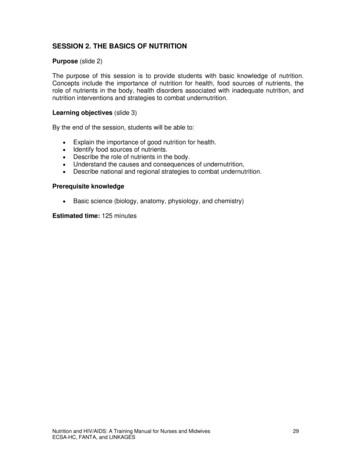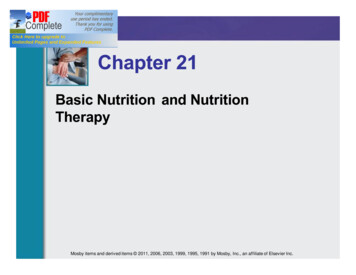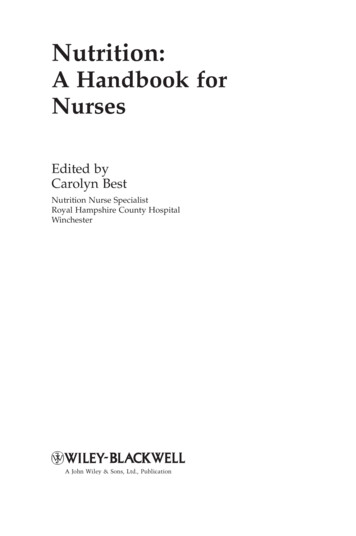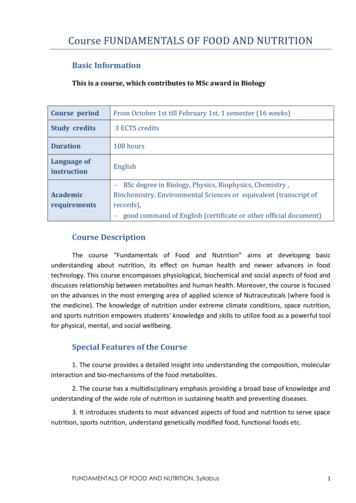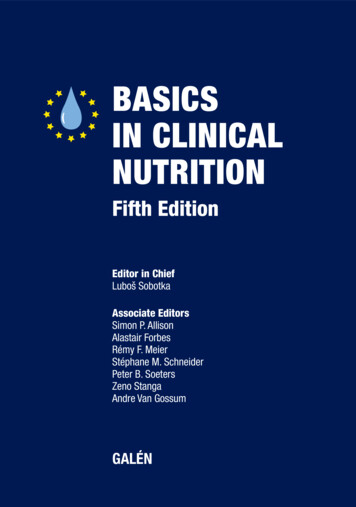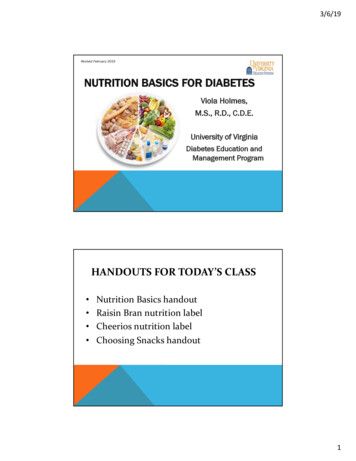
Transcription
An Introduction to NutritionA Thematic UnitTeaching and Leadership 8198 December 2004Ivette DunawayPeggy PorterAndSara Jane Richardson1
Table of ContentsOverview2Lesson 1How does Nutrition Apply to Me?4Lesson 2The Food Pyramid7GameName that Food20Lesson 3The Food You Eat22Lesson 4Why Do We Really Need Food?27Lesson 5Evaluating Food Labeling37Lesson 6Follow up to – The Food You Eat22InternetBag a McMeal41Lesson 7Nutrition on a Budget43Song“Shortenin’ Bread”44TESOL ESL Standards46Resources50Appendix Self Evaluation512
Overview of “An Introduction to Nutrition” Thematic UnitTeam Members: Ivette Dunaway, Peggy Porter, and Sara Jane Richardson“An Introduction to Nutrition” is designed to teach students how to apply concepts ofnutrition to their lives. They will become familiar with the elements of the Food Pyramidand how to interpret it. Through a journaling activity, the students will track their owneating habits and learn how to evaluate it’s nutritional contents. They will learn how thecomponents of the food they eat function in their bodies. They will learn how to evaluatefood labeling in order to make informed decisions when purchasing food. Through ashopping exercise, the students will practice applying their nutritional knowledge to anauthentic activity.The lessons in this unit are designed to create relevancy to the multicultural makeup ofthe student population. Students will be able to utilize knowledge from their own culturalbackground while participating in the activities. The activities create opportunities forindividual work as well as small group and large group interaction. Students have anopportunity to work with their families at home on several projects where they can applywhat they have learned in their daily lives.Goals:Content – Students will gain knowledge pertaining to nutrition and skills to apply theknowledge to their everyday lives.Language – Students will communicate in social and academic situations as they areintroduced to the concept of nutrition.Learning Strategies – Students will use songs, games, and an Internet activity toenhance learning within the content area. They will also be involved in creating visualaids to make the material more relevant and enrich their learning experience. Byplanning a meal using the Food Pyramid and a budget, students will integrate nutritionalknowledge and math skills to produce a realistic meal plan.Context:Grade Level: 9-10th gradeType of class: Regular classroom instruction in a high school health classNative Language: VariedEnglish Proficiency Levels: Varied3
How does Nutrition Apply to Me?Lesson 1Lesson Objectives:Students will gain knowledge, which will assist them in being able to define nutrition andidentify how it applies to their lives.*StandardsGoal 1 – 1, 2, 3Goal 2 – 1, 2, 3Goal 3 – 1, 3Materials Needed:One copy of “My guide to nutrition” and the ”Student Self-Evaluation”** needs to beprovided for each student.Bellringer:1. Write the following words on the board or overhead projector: diet, nutrient,(RDA) Recommended Dietary Allowance, The Food Pyramid, calorie, fat,protein, carbohydrate, vitamins, and minerals.2. Ask students to brainstorm about what the words mean and how they might applyto the word nutrition.Procedures:1. Students will take the Student Self-Evaluation to assess their own personalknowledge of nutrition and health.2. Introduce concepts, which encompass the role of nutrition in their everyday lives. Definition of nutrition Why does one eat? Nutrition throughout one’s life.3. The information can be presented in lecture format in which the students takenotes using “My guide to nutrition.” The lecture and discussion should includereferences to prior knowledge from the bellringer as well and the self-evaluationto establish relevance to the information being presented.4. An alternative to step 3: Create a handout with the information, which could beread as a class and discussed.Evaluation:Students will be asked to establish goals for themselves based on their self-evaluationresults and the knowledge they have gained from the lesson.*refer to ESL standards document** Student Self-Evaluation is located in the appendix4
“My Guide to Nutrition”1. What is nutrition?2. What is a nutrient?3. What role does physical health play into nutrition?4. What role does Culture play into nutrition?5. What role does one’s environment play into nutrition?6. What role does one’s emotion play into nutrition?7. During your life when is nutrition important?8. Is nutrition important to teenagers? Why or Why not?9. How has your culture and family influenced your food habits?10.Compare your food habits with those of a friend. Give a few reasons why theremight be differences in habits.5
“My Guide to Nutrition”Teacher edition1. What is nutrition? The science of looking at how the body uses nutrients and athow and why people eat.2. What is a nutrient? Substances in food that the body needs to function properly.3. What role does physical health play into nutrition? Eating the right amountsand kinds of foods gives energy and stamina for active life-styles. A nutritiousdiet provides for growth and maintenance of a healthy body and helps keep youmentally alert.4. What role does Culture play into nutrition? Your food choices reflect theculture you live in, as well as your ethnic background and perhaps your religiousbeliefs. Teenagers have a culture of their own, too.5. What role does one’s environment play into nutrition? Your food choices arelinked to many factors. Your cultural heritage, your family and socialrelationships, media messages, and life-style all influence the foods you like andchoose.6. What role does one’s emotion play into nutrition? Eating is closely tied toemotions. Eating to relieve tension or boredom can result in overeating.However, if you lose your appetite when you are upset or bored, you may missout on getting essential nutrients. By understanding how eating relates toemotions, you can make more healthful food choices.7. During your life when is nutrition important? At every stage in life, goodnutrition is essential for health.8. Is nutrition important to teenagers? Why or Why not? Nutrition is importantto teenagers because adolescence is the period of the fastest and most growth youwill experience. Adolescence is also a time when your life-style is probably avery active one. Good nutrition is important to both your growth and the energyyou need to maintain an active life-style.9. How has your culture and family influenced your food habits?10.Compare your food habits with those of a friend. Give a few reasons whythere might be differences in habits.6
The Food PyramidLesson 2Lesson Objectives:Students will learn be able to identify The Food Pyramid and apply knowledge gained totheir life and diet. Students will identify names, correct portions, food types and basicnutrients for each food group in the food pyramid.*StandardsGoal 1 – 1, 2, 3Goal 2 – 1, 2, 3Goal 3 – 1, 2, 3Materials Needed:Each student will need one copy of the Pyramid Bingo grid, and The Food Pyramid.Teachers will need to make an over-head of the information given on the pyramid anddaily requirements. One copy of The Pyramid Quiz is needed for each student. Allmaterials for “Name that Food” are needed as well.Procedures:1. As an introduction activity give students a copy of The Food Pyramid, and thePyramid Bingo grid. Have students play the bingo game to introduce themselvesto all the different levels and parts of the pyramid.2. Go over with an over-head projector the information given on The Food Pyramid.When students seem comfortable with the information and have had a chance toreview a couple of days, administer The Food Pyramid Quiz.3. As a multi-culture activity give students an opportunity to discuss how The FoodPyramid recommendations are different than those of their native country.4. For the follow-up activity before the next lesson, have students play the game,“Name that Food.”5. An alternative activity with the Internet, have students research food pyramids oftheir native countries and compare with the American Food Pyramid.Evaluation:Students will pass The Food Pyramid Quiz with an 80% or better. From the game, “Namethat Food” students will demonstrate knowledge of different types of food and wherethey would fit on The Pyramid.*refer to ESL standards document7
Food PyramidThe Food Pyramidfrom U.S. Department of Agriculture and the U.S. Department of Health8
The Food Pyramid QuizFill in the Pyramid correctly with the five food groups and the correct amount of servingsyou need from each group for one day. With the 5 blanks at the bottom of the page fillout one food from your own country that would fit in each of the five food groups.1.2.3.4.5.9
TEACHER QUESTIONS FOR PYRAMID BINGO1. Which food group contains cheeses? MILK2. Which food group contains peas, carrots, and corn? VEGETABLES3. Which food group contains rice? GRAIN4. Which food group contains peanut butter? MEAT5. Which food group contains oranges, apples and bananas? FRUIT6. How many servings of the milk group should you eat daily? 2-3 SERVINGS7. How many servings of the meat group should you eat daily? 2-3 SERVINGS8. How many servings of the vegetable group should you eat daily? 3-5 SERVINGS9. How many servings of the fruit groups should you eat daily? 2-4 SERVINGS10. How many servings of breads and cereals should you eat daily? 6-11 SERVINGS11. What is one serving of the milk group? 1 cup milk or yogurt, 1 1/2 to 2 ounces ofcheese12. What is one serving of the meat group? 1 1/2 to 3 oz. of cooked lean meat, poultry, orfish, 1/2 cup cooked beans, 2 Tbsp. peanut butter13. What is one serving of the vegetable group? 1/2 cup chopped raw or cookedvegetables, 1 cup leafy raw vegetables14. What is one serving of the fruit group? 1 piece of fruit or melon, 3/4 cup juice, 1/2cup canned fruit, 1/4 cup dried fruit15. What is one serving of the bread group? 1 slice bread, 1/2 cup cooked rice or pasta,1/2 cup cooked cereal, 1 oz. ready-to-eat cerealGive each student a copy of the Pyramid Bingo grid. Students will fill in the boxeswith words and phrases from The Food Pyramid.10
11
Food Guide PyramidWhat is the Food Guide Pyramid?The Food Guide Pyramid is a graphic guide of what to eat each day. It will help peoplefollow the Dietary Guidelines for Americans. The Food Guide Pyramid was developedby the U.S. Department of Agriculture (USDA) and supported by the U.S. Department ofHealth and Human Services. The Dietary Guidelines provide advice for better health.Following the Dietary Guidelines can help reduce your chances of developing certaindiseases. The guidelines are designed for healthy Americans aged 2 and up.How is this guide different from the guides I have used in the past?The Food Guide Pyramid is a new graphic to help people think about healthy eating. Therecommended number of servings for some of the food groups is different on the Pyramidthan the recommendations found on other food guides, such as the "Basic Four." ThePyramid is designed to help people get the nutrients they need and avoid too much fat orsugar.Why should I use the Food Guide Pyramid?It is based on current research about diet and health and was developed by the U.S.Department of Agriculture. The Food Guide Pyramid should be used with students inplace of the "Basic Four" or other food guides you may be using.What do the different pieces of the pyramid mean?The Food Guide Pyramid emphasizes eating foods from the five major food groupsshown in the pyramid's three lower levels. None of these major food groups is moreimportant than another - for good health, you need them all. Each of these food groupsprovides some, but not all, of the nutrients you need. Foods in one group can't replacethose in another. Fats, oils and sweets are at the Pyramid tip. People should use thesesparingly.Why is there a range of servings for each food group?The number of servings people need depends on their age, sex, size, and activity level.For example, an active male teenager needs more servings than a less active, olderwoman. Almost everyone should have at least the lowest number of servings in eachrange. Preschool children need the same variety of foods but may need smaller servings.Be sure, however, that preschoolers eat or drink two full servings from the milk groupdaily.Why are the recommended number of servings for the bread, fruit, andvegetable groups higher on this guide than on others I have used in thepast?Most people need to eat more of these foods for the complex carbohydrates (starches),vitamins, minerals, and fiber they supply. Fruits, vegetables, and foods from the bread12
group are low in fat, unless they are prepared with added fat as are French fries,doughnuts, or croissants.Cookies, cakes, and doughnuts are made with flour. Does that mean theyare part of the breads, cereals, rice and pasta group?Yes. Foods such as cookies, cakes and doughnuts are part of this group. However, theyare high in fat and sugars and people should eat them only occasionally.Why are the symbols for fat (a round dot) and added sugar (a triangle) atthe Pyramid tip but also throughout the Pyramid?Fat and added sugar is found in many types of food and in most of the food groups. Fatand added sugars are shown mainly in foods from the pyramid tip (fats, oils, and sweets).But symbols are shown in all food groups as a reminder that some choices in these groupscan be high in fat or added sugar. You need to select wisely from within each food group.Food Guide Pyramid - A Guide to Daily Food ChoicesBread, Cereal, Rice and Pasta Group (6-11 servings)This group includes foods from grains. You need the most servings of these foods eachday since they provide the base of the pyramid. These foods provide complexcarbohydrates (starches), which are an important source of energy, vitamins, minerals,and fiber. What counts as a serving? 1 slice of bread, 11 ounce of ready to eat cereal, and1/2 cup of cooked cereal, rice, or pasta.Vegetable Group (3-5 servings)Vegetables provide vitamins, such as vitamins A and C, and folate, and minerals, such asiron and magnesium. They are naturally low in fat and also provide fiber. What counts as1 serving? 1 cup of raw leafy vegetables, 1/2 cup of other vegetables - cooked or choppedraw; 3/4 cup of vegetable juice.Fruit GroupFruits and fruit juices provide important amounts of vitamin A and C and potassium.They are low in fat and sodium. What counts as a serving? A medium apple, banana, ororange; 1/2 cup of chopped, cooked or canned fruit; 3/4 cup of fruit juice.Meat, Poultry, Fish, Dry Beans, Eggs, and Nuts (2-3 servings)Meat, poultry, and fish supply protein, B vitamins, iron, and zinc. Dry beans, eggs, andnuts are similar to meats in providing protein and most vitamins and minerals. Whatcounts as a serving? 2-3 ounces of cooked lean meat, poultry, or fish; 1/2 cup of cookeddry beans, 1 egg, or 2 tablespoons of peanut butter (count as 1 ounce of meat). The totalamount of these servings should be the equivalent of 5 to 7 ounces of cooked lean meat,poultry, or fish per day.Milk, Yogurt, and Cheese (2-3 servings)Milk products provide protein, vitamins, and minerals. Milk, yogurt, and cheese are thebest sources of calcium. What counts as a serving? 1 cup of milk or yogurt; 1 1/2 ouncesof natural cheese; 2 ounces of process cheese, Two servings for most people and servingsfor women who are pregnant or breast-feeding, teenagers, and young adults to age 24.13
Fats, Oils, Sweets (use sparingly)It is recommended that Americans limit fat in their diets to 30 percent of calories. Thisamounts to 53 grams of fat in a 1600 calorie diet, 73 grams of fat in a 2200 calorie diet,and 93 grams of fat in a 2800 calorie diet. All food groups contain low fat choices.Choosing a diet low in sugar is important for people who have low calorie needs. Sugarsinclude white sugar, brown sugar, raw sugar, corn syrup, honey, and molasses; thesesupply calories and few other nutrients. Sugar might be added to foods in the groups, butother foods, which are high in sugar, are candy, soft drinks, jams, and jellies.How Many Servings is Right for Me?The pyramid shows a range of servings for each food group. The number of servings thatare right for you depends on how many calories you need, which in turn depends on yourage, sex, size, and how active you are. Almost everyone should have at least the lowestnumber of servings in the ranges.For Young ChildrenPreschool children need the same variety of foods as older family members do, but mayneed fewer calories. The can eat smaller servings which will be less calories, but theyshould have at least 2 cups of milk per day.Combination foodsFor mixed foods, do the best you can to estimate the food group servings. For example, aslice of pizza has servings from the bread group (crust), milk group (cheese) andvegetable group (tomato).Dietary GuidelinesThe United States Department of Health, Education and Welfare and the United StatesDepartment of Agriculture (USDA) established the dietary guidelines. They are intendedfor people who are healthy and may not apply to special needs diets or conditions.Good health depends upon many things, including heredity, lifestyle, personality traits,mental health, attitudes, and environment. Food alone cannot make you healthy, orguarantee well being. Good eating habits that are based upon the seven guidelines andexercise can help keep you healthy and improve your health.The dietary guidelines are:1. Eat a Variety of Foods:1. Our bodies need approximately 40 different nutrients. Nutrients are foundin the foods a person eats.2. No single food item supplies all the nutrients needed by the human body.3. The greater the variety of food we eat, the less chance we have ofdeveloping a deficiency or excess of any single nutrient.4. Foods should be selected according to the food pyramid guidelines toassure a variety of food and a well-balanced diet.2. Maintain a Healthy Weight:1. Many diseases and disorders are associated with obesity.1. high blood pressure14
2. increased levels of blood fats and cholesterol3. diabetes in older people4. heart attacks5. strokes2. The desirable weight for each person is different, depending upon framesize and build. Do not compare yourself to others.3. Improved eating habits help one maintain a healthy weight.1. Eat slowly.2. Prepare smaller portions of food.3. Eat when hungry, allowing 10-20 minutes after eating beforetaking more food. This allows your body to deciding if you arereally hungry.4. Increase everyday physical activities.5. Do not attempt to decrease weight below your acceptable range. Do noattempt to lose weight until you are an adult or your growth is complete.Children who are obese can grow into their weight by regularly exercisingand avoiding or limiting choices from the fats, oils, and sweets group.Children should not try to lose weight unless they are under close medicaldirection.3. Choose a diet low in fat, saturated fat, and cholesterol.1. Avoid too much fat, saturated fat, and cholesterol. (The backs of the DairyCouncil Comparison Cards illustrate the amount of fat contained in eachfood. It is a graphic and easy way for students to understand this concept.)1. Choose lean meat, fish, poultry, dry beans and peas as proteinsources. Lean meats do not leave much fat in a pan when they arecooked.2. Moderate your use of eggs and organ meats, such as liver.3. Limit your intake of butter, cream, hydrogenated margarine,shortenings, palm and coconut oil, and foods made from suchproducts.4. Trim excess fat off meats; take skin off of poultry before cooking,and rinse hamburger in hot water after cooking to reduce fatcontent.5. Broil, bake, or boil rather than fry when cooking foods. Use fatfree sprays in pans when baking rather than oil or shortening.6. Read labels carefully to determine both amount and types of fatcontained in foods. (Animal fats are usually higher in saturated fatsthan vegetable oils. The exceptions are coconut oil which is 86percent saturated, palm kernel oil is 81 percent, beef fat is 50percent, cottonseed is 26 percent, other vegetables oils are less than20 percent saturated.)2. Avoiding high fat intake will decrease the chance of heart attack and limitnutrient-poor calorie intake. Diets low in fat and cholesterol are factorsthat we can control when trying t avoid the risks of heart disease.3. These guidelines are not to prohibit the use of any specific food item.Moderation is the key.Assignment: Students are given an allowance of 10 grams of fat for an afterschool snack. How much snack can you get for your fat? (Using the backs of theDiary Council Comparison Cards will make this activity more fun for thestudents.)15
4. Choose a diet with plenty of vegetables, fruits, and grain products - Refer topyramid and compare numbers and sizes of servings for these food groups. Pointout that the ingredient list on breads must say 'whole wheat flour' if you want toincrease your fiber intake. "Wheat bread" often has coloring, not whole wheat,added to the white bread recipe.1. These foods are a major source of energy in the average diet.2. Carbohydrates contain less than half the number of calories per gram thanfat does.3. Complex carbohydrate foods, such as breads, cereals, pasta, rice, drybeans, dry peas, and other vegetables such as potatoes and corn, containmany essential nutrients.4. These foods increase dietary fiber.5. Use sugars only in moderation.1. It is estimated that every American uses more than 130 pounds of sugarand sweeteners each year (about 3/4 cup of sugar each day). Too muchsugar is undesirable because it provides calories without nutrients so youeither do not get all the nutrients you need or you have to eat more caloriesthan you need to get adequate nutrition. Students are amazed to see theactual amount of sugar contained in foods. You may wish to take a bowlof sugar, a glass test tube and measuring spoons and demonstrate howmuch sugar is contained in some foods they eat. For example: Tell theclass that a can of 7-Up contains 9 teaspoons of sugar. Then measure outnine teaspoons of sugar into the test tube for them to see how much sugarthey are drinking when then drink 7-Up. If you eat meals or snacks with alot of sugar in them, you soon feel hungry again. You get a quick burst ofenergy, which fizzles out quickly. Foods without a lot of sugar in themkeep you feeling full longer.2. Health hazards from eating too much sugar include tooth decay andweight gain.3. People should read labels to discover the types and amounts of sugar in aproduct. Ask students these multiple-choice questions.1. How much sugar is in 12 ounces of 7-Up?1. 9 tsp.2. 3 tsp.3. 1 tsp.4. 30 tsp.2. How much sugar is in 1/2 cup of Jello?1. 6 tsp.2. 2 tsp.3. 3 tsp.4. 4 1/2 tsp.3. How much sugar is in a glazed donut?1. 3 tsp.2. 4 Tbs.3. 6 tsp.4. 1 tsp.4. How much sugar is in one large marshmallow?1. 1 1/2 tsp.2. 3 tsp.3. 1/2 tsp.4. 4 tsp.16
5. Which of the following contains 3 teaspoons of sugar? (Answer is:all)1. 1 Tbs brown sugar2. 1 Tbs corn syrup3. 1 Tbs granulated sugar4. 1 Tbs honey4. Some tips for avoiding excessive sugar:1. Use less sugar in all its forms. What are some of the names forsugar? Sucrose is a simple sugar (draw one link of a chain on theboard). Fructose is the sugar in fruit, (draw 2 links of a chainjoined together). Lactose is the sugar in milk (Three circles hoodedtogether). Maltose is the sugar from grains such as corn syrup,brown sugar; molasses, etc. (make a more complicated chainmodel). Simple sugars are broken down and digested very quickly.Complex carbohydrates take longer to break down and digest.Therefore, if you eat a high sugar content cereal for breakfast, youwill be hungry more quickly than if you eat a cereal with complexcarbohydrates. If you add one teaspoon (5 grams) of sugar tocereal, you have increased the simple carbohydrates, but you havenot subtracted any of the complex carbohydrates. I you add abanana, rather than sugar, you are adding more complexcarbohydrates.2. Eat fewer foods containing sugars, such as candy, soft drinks, icecream, cakes, and cookies.3. Eat more fresh fruits.5. How often you eat sugar is as important as how much sugar you eat inrelation to tooth decay.6. Use salt and sodium only in moderation. Salt is made from sodium andchloride. They are essential elements in limited amounts.1. Sodium is present in many beverages and foods we eat. One teaspoon ofsalt contains 2000 milligrams of sodium. A safe and adequate amount is1000-3000 milligrams each day. We can get that much sodium withoutadding salt to anything.2. Americans consume much more sodium than their bodies require. (Somepeople consume 10 times as much sodium as they need daily.)3. High blood pressure is a major health risk of excessive sodium use.4. Ways to reduce sodium intake include:1. Use less table salt.2. Eat foods high in sodium only in moderation (potato chips,pretzels, salted nuts, cheese, pickled foods, and cured meats).3. Learn to enjoy unsalted, natural flavors of food.4. Read food labels carefully to determine amounts of sodiumpresent. Monosodiumglutimate (MSG), backing soda, garlic salt,and onion salt, soy sauce, bullion, medications, etc., also containslarge amounts of sodium.7. If you drink alcoholic beverages, do so in moderation.This guideline is written for people over 21 years of age. Depending upon howmuch this topic is covered in other classes taught at your school, this may be agood time to discuss the serious problems related to drinking alcoholic beverages.High school students should not be drinking alcoholic beverages - it is against thelaw.17
Using the Food Guide PyramidThe suggested numbers of servings to eat daily from each food group and what counts asa serving are listed below. Use this guide to help you make decisions on healthy foodchoices.What Counts as OneFood GroupsSuggested Daily ServingsServing?Fats, Oils, andSweetsUse sparingly. Go easy on fats (butter,salad dressings, margarine, oils, andgravy) and sugars (candy, soft drinks,syrups, and jellies). Use less fat andsugar in cooking and at the table.Milk, Yogurt ,and Cheese2 to 3 servings (at least 3 servings forteens and adults through age 24, and forpregnant and breast feeding women);two servings for everyone else. Meat, Poultry,2 to 3 servingsFish, Dry Beans,Eggs, and Nuts Vegetables3 to 5 servings Fruits2 to 4 servings 181 cup of milk oryogurt1 1/2 to 2 ounces ofnatural cheese (such ascheddar)2 ounces of processcheese (such asAmerican)2 to 3 ounces ofcooked lean meat,poultry or fishCount 1/2 cup ofcooked dry beans, 1egg, or 2 tablespoonsof peanut butter as 1ounce of meat (about1/3 serving).1 cup of raw, leafyvegetables1/2 cup of othervegetables, cooked orraw3/4 cup of vegetablejuice1 medium apple,banana, orange, orother whole fruit1/2 cup of chopped,cooked, or cannedfruit3/4 cup of fruit juice(only 100 percent fruitjuice can be countedas fruit).
Bread, Cereal,Rich, and Pasta6 to 11 servings (include foods madefrom whole grains). 19as fruit).1/4 cup of dried fruit1 slice of bread or 1tortilla1 ounce of read-to-eatcereal1/2 cup of cookedcereal, rice, or pasta1/2 of a mediumdoughnut or croissant1/2 of a hamburgerbun, bagel, or Englishmuffin
Name that Food!Food Pyramid game and activityPurpose: Students will be able to classify different food items into the correctcategories of the Food Pyramid, identify foods that keep our bodies healthy, and create aFood Pyramid booklet.Materials Needed:1.2.3.4.5.6.7.Construction PaperNotebook PaperMagazines or NewspapersRibbonScissorsGlueOverhead Picture of the Food PyramidProcedure:1. Display a variety of foods on a table. Display an overhead picture of the FoodPyramid.2. Review with students the different levels of the Food Pyramid and the daily servingswe need from each group to keep our bodies healthy.3. Show the students an example of the booklet they will be making. Explain thefollowing procedures:1. Choose two pieces of construction paper, and six sheets of notebook paper.2. Place the notebook paper between the sheets of construction paper. Punch 3 holesalong the left edge. Tie pieces of ribbon through the holes.3. On each page, write the name of a Food Pyramid section, and the number ofservings suggested. Glue the appropriate pictures of food items, cut frommagazines or newspapers, to the pages of your booklet.4. Decorate the cover of your Food Pyramid booklet!Evaluation:Hold up each of the food items displayed on the front table. Ask the students to identifyits place on the Food Pyramid.Each of the students will work independently to cut out food pictures from magazines andnewspapers, and construct a Food Pyramid booklet.Summarize the information covered in the lesson, and play a game of Name That Food.20
Name That Food:Divide the class into several small teams. Each team will need a pencil and a piece ofpaper. The teacher selects a section from the Food Pyramid, and a letter of the alphabet.For example, foods from the bread and cereals group that start with the letter "B." Thestudents have one minute to record a list of foods. When the minute is up, each groupreads their list. The teacher records the number of items on each group's list, and anothercategory and letter are selected. The game continues until all sections of the pyramidhave been covered. The group with the highest score wins the game!21
The Food You EatLesson 3 and 6Lesson Objective:To keep a food journal for a 3-day period to see if nutritional requirements are met on aregular basis.Materials: Student SheetsJournalComputers with Internet accessArticle “Stock Up Before You Leave”*StandardsGoal 1 – 1, 2, 3Goal 2 – 1, 2, 3Goal 3 – 1, 2, 3Pre-Lesson Instructions: This lesson involves students keeping a food journal over a 3-day period. Thislesson may work best if assigned on a Thu
Overview of “An Introduction to Nutrition” Thematic Unit Team Members: Ivette Dunaway, Peggy Porter, and Sara Jane Richardson “An Introduction to Nutrition” is designed to teach students how to apply concepts of nutrition to their lives. They will become familiar with the elements of the Food Pyramid and how to interpret it.File Size: 958KBPage Count: 52Explore furtherBest Printable Nutrition Handouts - Food and Health .foodandhealth.comPrintable Materials and Handouts Nutrition.govwww.nutrition.govBASIC NUTRITION WORKBOOKwww.onlineordersff.comNUtrition notes.pdf - MODULE 1 INTRODUCTION TO NUTRITION www.coursehero.comNutrition Worksheets – TheWorksheets.CoM .www.theworksheets.comRecommended to you b



